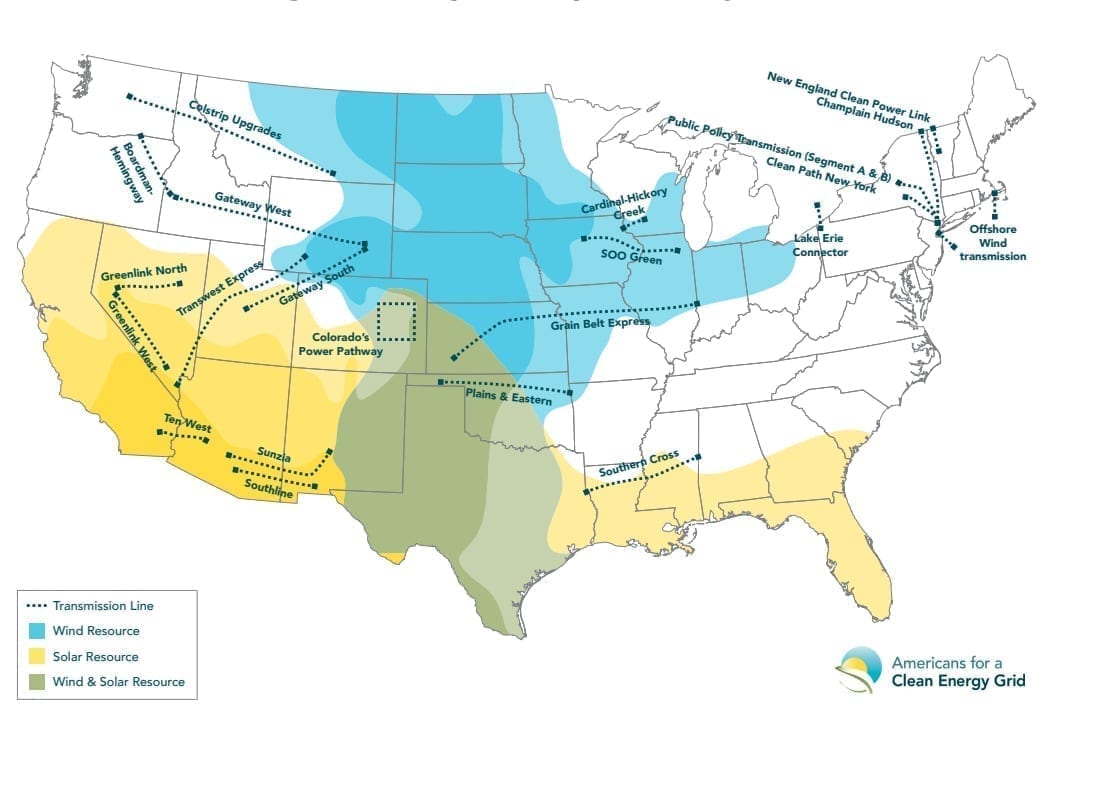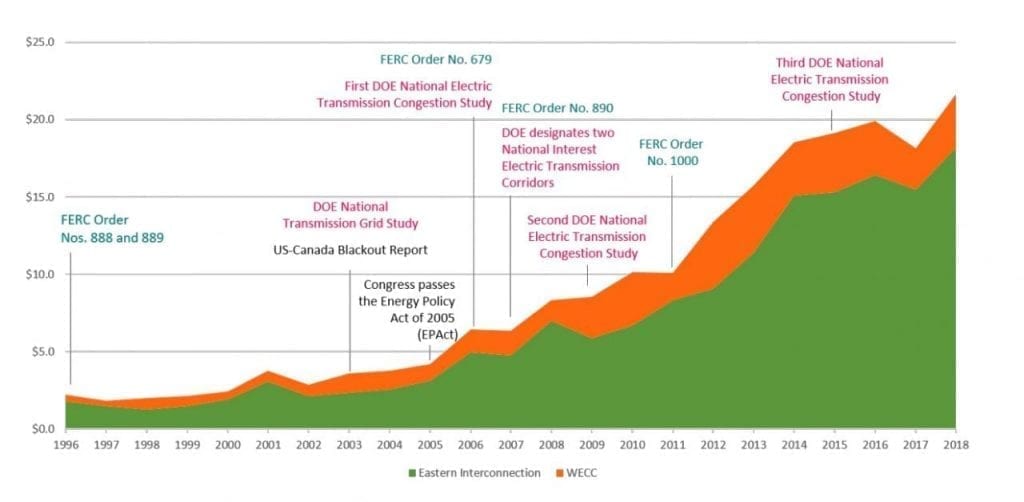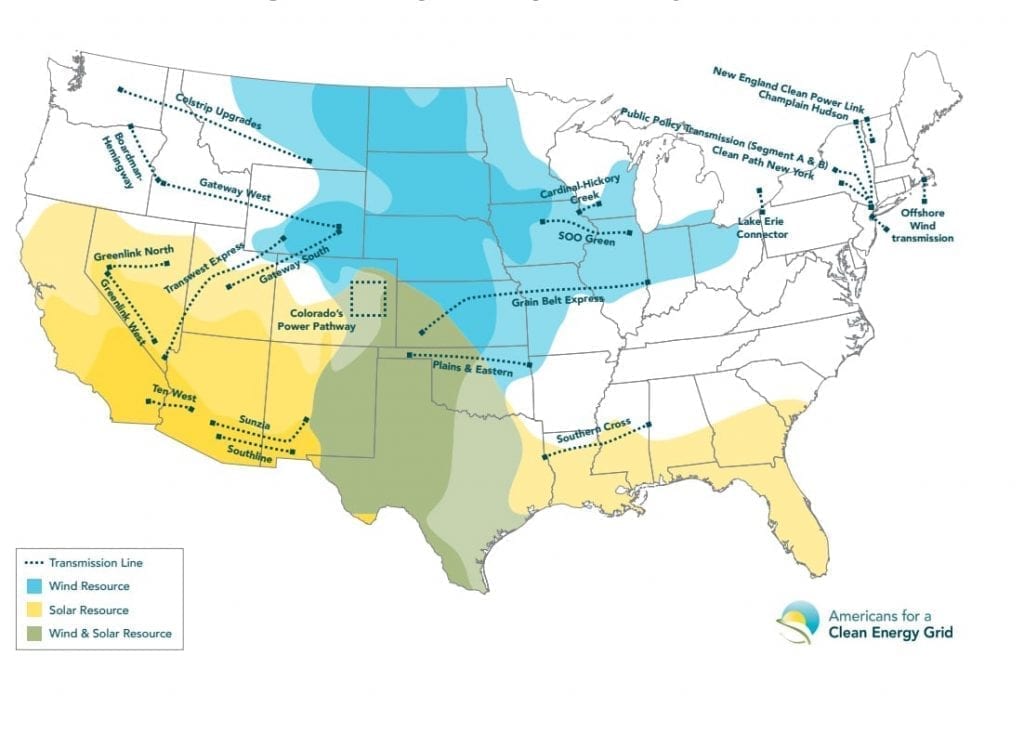Heavy Push by Industry, Biden Administration to Jumpstart Transmission Expansion, Grid Modernization
The post Heavy Push by Industry, Biden Administration to Jumpstart Transmission Expansion, Grid Modernization appeared first on POWER Magazine.

Bolstering the Biden administration's recently announced initiatives to modernize the nation's grid and improve its resilience, the Department of Energy (DOE) on April 27 made up to $8.25 billion in loans available to expand transmission capacity nationwide, while the Department of Transportation (DOT) offered new guidance to help speed the siting and permitting of transmission lines.
Separately on Tuesday, 29 industry leaders formed a new grid investments advisory council, and non-profit advocacy coalition Americans for a Clean Energy Grid (ACEG) issued a report identifying 22 shovel-ready" high-voltage transmission projects that could help deliver 60 GW of new renewable capacity across the U.S.
Urgency for Grid Modernization Amid a Changing Power LandscapeThe announcements on Tuesday are a remarkably coordinated push for action to modernize the nation's grid. While industry has called for a holistic modernization of the bulk power system for decades to enable more efficient and reliable power generation and delivery, action has often been piecemeal and catered to changing market and policy forces.
According to the Energy Information Administration, the U.S. bulk power system in 2019 comprised 22,731 electric generators at about 10,346 utility-scale electric power plants. Once generated, their power is delivered over more than 600,00 circuit miles of transmission lines, including 240,000 that are considered high-voltage. Another 5.5 million miles of local distribution lines carry power to their final destination. Most of the grid is privately owned: Around 72% of U.S. power customers are served by for-profit investor-owned utilities, while rural cooperatives serve the rest. Federal and state agencies have regulatory authority over generation and transmission systems, while customer rates are generally regulated by state and local agencies.
Owing to this complexity, just how old the currently operational transmission system is hard to pinpoint. The DOE in its 2015 Quadrennial Technical Review quoted a 2005 report that suggested about 70% of the grid's transmission lines and power transformers were at least 25 years old, and 60% of circuit breakers were 30 years or older-but the 2005 figure has been repeatedly quoted in official documents to describe the transmission system's aging assets.
In a September 2020 report, the American Society of Civil Engineers (ASCE) suggested the bulk of the transmission system was built in the 1950s and 1960s, with a 50-year life expectancy, meaning they have reached or surpassed their intended lifespan." The organization added: Aging transmission components can contribute to higher failure rates, more widespread outages, and longer recovery times. Outages contribute to financial loses not only for a utility company, but businesses and customers that rely on this power."
As a bright spot, however, investment in transmission has surged since 2005. In the DOE's fourth triennial National Electric Transmission Congestion Study (released in September 2020), the agency determined transmission investment has significantly increased from about $5 billion per year in 2005 to $22 billion per year since 2014. The Edison Electric Institute, which represents all investor-owned utilities, last year projected transmission investments would reach $26.1 billion for 2020. This increased investment can be attributed to several factors including the need to replace aging infrastructure, resilience measures against severe weather events, new reliability standards, and advanced technologies to name a few," said EEI.
 The DOE's 2020 National Electric Transmission Congestion Study concluded transmission investment has contributed to reduced transmission congestion, but it also credits reductions in congestion to the stagnant electricity demand growth and lower prices for natural gas. However, it cautioned, a much wider range of data-much of which is not now coordinated systematically or collected comprehensively-is needed to assess how national interests are being affected by the ongoing evolutionary changes in the relationship between transmission networks and the broader electricity system." Source: DOEDOE, DOT Act to Facilitate Transmission Expansion in Light of Other Biden Measures
The DOE's 2020 National Electric Transmission Congestion Study concluded transmission investment has contributed to reduced transmission congestion, but it also credits reductions in congestion to the stagnant electricity demand growth and lower prices for natural gas. However, it cautioned, a much wider range of data-much of which is not now coordinated systematically or collected comprehensively-is needed to assess how national interests are being affected by the ongoing evolutionary changes in the relationship between transmission networks and the broader electricity system." Source: DOEDOE, DOT Act to Facilitate Transmission Expansion in Light of Other Biden MeasuresThe White House's efforts on Tuesday, however, are rooted in recent power system debacles-including power supply disruptions in Texas, the Midwest Independent System Operator, and the Southwest Power Pool this February-as well as its ambitious plans to transform the nation's generation profile.
Along with proposing a 100% carbon-free power target by 2035, the Biden administration in March rolled out a national 30-GW offshore wind target. Citing an urgent need for resiliency, the American Jobs Plan," a $2.25 trillion blueprint to overhaul the nation's infrastructure released on March 31, urged Congress to invest $100 billion to modernize the grid.
The Jobs Plan also proposed creation of a targeted investment tax credit (ITC) that incentivizes buildout of 20 GW of high-voltage capacity power lines-and it also calls for mobilization of tens of billions in private capital off the sidelines-right away." Also of note: Biden's plan proposes to establish a new Grid Deployment Authority under the DOE that better leverages existing rights-of-way (along roads and railways) and supports creative financing tools to spur additional high priority, high-voltage transmission lines."
The DOE on April 27 offered two separate financing streams to support transmission development: up to $5 billion in loan guarantees from the Loan Programs Office (LPO), and up to $3.25 billion from the Western Area Power Administration (WAPA's) Transmission Infrastructure Program (TIP) revolving loan program.
The LPO's Title 17 Innovative Energy Loan Guarantee Program and Tribal Energy Loan Guarantee Program will allow the DOE to support innovative transmission projects along with transmission projects owned by federally recognized tribal nations or Alaska Native Corporations," the DOE said. Projects include high-voltage direct current (HVDC) systems, transmission to connect offshore wind, and facilities sited along rail and highway routes. WAPA's TIP is a congressionally mandated federal debt financing program to support transmission and related infrastructure projects in the Western U.S.
Guidance issued by the DOT, meanwhile, applies to the agency's Field Highway Administration (FHWA) offices who work with state DOTs. It clarifies how state DOTs can leverage certain uses of highway right-of-way (ROW) to expand transmission lines, build renewable projects, deploy broadband, and support electric vehicle charging.
In a statement, the DOT said the expansion and modernization of the grid using public lands adjacent to transportation systems can create revenue opportunities that will lower state costs, reduce transportation maintenance expenses, cut greenhouse gas and other pollutant emissions, promote energy security and diversity, and foster the creation of good-paying local jobs."
New Industry Grid Investment Advisory CouncilOn Tuesday, notably, the White House also highlighted the formation of a new Grid Investments Advisory Council (GIAC) by 29 industry leaders-largely from the power sector, but also environmental groups, labor unions, and grid-serving technology firms.
The White House said the council has called for a special focus on the large-scale deployment of smart grid technologies that will increase capacity while building flexibility and resilience into our national grid."
GIAC member entities so far include Itron, Hitachi, AEP, Exelon Utilities, GE Digital, Large Public Power Council, American Public Power Association, Smart Electric Power Alliance, Reed Smith LLP, the Electric Power Research Institute, National Rural Electric Cooperative Association, Natural Resources Defense Council, Edison Electric Institute, Edison International, Portland General Electric, Austin Energy, Schneider Electric, C3 ai, Utility Workers Union of America, International Brotherhood of Electrical Workers, IBM, the DOE, Microsoft, Climate Justice Alliance, and Google X.
The council will be led by New York Power Authority President and CEO Gil Quiniones (who also serves as chair of the GridWise Alliance (GWA) board; the 2003-established GWA is a coalition of stakeholders that design, build, and operate the grid). Quiniones said on Tuesday that GIAC will support GWA's call for at least $50 billion in federal spending to modernize the nation's power transmission and distribution system.
The GIAC and GridWise Alliance will work collaboratively with the Biden Administration to define areas where investment in the electric grid would be most beneficial to the economy and the communities in most need," GridWise said. The Council will amplify the best practices of Alliance members; put a spotlight on key policy and appropriation recommendations; and utilize its utility executives, grid equipment manufacturers, and vendor members to advocate funding for grid modernization."
22 Shovel-Ready' High-Voltage Transmission ProjectsFinally, on Tuesday, Americans for a Clean Energy Grid (ACEG) and the Macro Grid Initiative-a joint effort by the American Council on Renewable Energy and Americans for a Clean Energy Grid-issued a report identifying 22 shovel-ready" high-voltage lines. ACEG is an entity that says it is the only non-profit broad-based public interest advocacy coalition focused on the need to expand, integrate, and modernize the North American high-voltage grid." Macro Grid Initiative is a joint effort by the American Council on Renewable Energy and Americans for a Clean Energy Grid. Consultancy group Grid Strategies authored the report, Transmission Projects Ready to Go: Plugging into America's Untapped Renewable Resources.
The report suggests the lines-an equal mix of alternating current (AC) and direct current (DC)-would add around 8,000 miles and 42 GW of new transfer capacity-which is only about 3% of the total mileage of the operating transmission system. However all the proposed lines operate at a high voltage, which allows them to carry more power than typical existing transmission lines with lower losses. As a result, these lines increase the transmission system's transfer capacity by about 11 to 12%, and enable a 50% increase in domestic wind and solar generation," it says.
The 42 GW of additional transfer capacity could enable the interconnection of around 60 GW of additional renewable capacity, the report claims. Based on the ability to use the geographic diversity of wind and solar resources to obtain a more constant output profile, and the complementarity between wind and solar output profiles, it is typically possible for the nameplate capacity of wind and solar attached to a transmission line to exceed the transfer capacity of the line by around 50%," it explains.
The output of the renewable generators delivered by these transmission lines would also be high, as they access some of the highest quality wind and solar resources in the country. Wind and solar projects developed in many of the resource areas accessed by these lines can exceed 50% and 30% capacity factors, respectively, which are well above average," the report says.
The report's proposed projects include:
- New England Clean Power Link. A 320-kV, 150-mile DC line mostly running under Lake Champlain and into Vermont, delivering Canadian power to New England.
- Clean Path New York. A 320-kV, 265-mile DC line delivering renewable energy from upstate New York to New York City.
- Champlain Hudson. A 300-kV, 330-mile DC line mostly running under Lake Champlain and the Hudson River, delivering Canadian power to New York City.
- New York public policy transmission. This entails upgrades, including via a 345-kV, 100-mile line, to New York's AC transmission system to interconnect more renewable energy.
- Offshore wind projects. According to the report, this broad item accounts for the underwater transmission to interconnect the first phases of proposed offshore wind projects in New York and New England."It notes: While other offshore transmission projects will likely be developed to meet state requirements, only the first phase of offshore projects are included in this report as these projects are in relatively advanced development and have signed interconnection agreements, while in many cases the type of interconnection for subsequent projects is still being determined." The multiple projects are envisioned as 300-kV lines.
- Lake Erie Connector. A 320-kV, 73-mile DC line under Lake Erie, connecting Ontario with PJM Interconnection.
- Southern Cross. A 500-kV, 400-mile DC line connecting the Electric Reliability Council of Texas (ERCOT) grid with southeastern power markets through a proposed converter station in Mississippi.
- SOO Green. An underground 525-kV, 350-mile DC line running under existing railroad right-of-way from Iowa to near Chicago.
- Cardinal - Hickory Creek. A new 345-kV, 100-mile AC line from near Dubuque, Iowa to Madison, Wisconsin. This line is the last of Midcontinent Independent System Operator's Multi-Value Projects (MISO's MVPs)," the report notes.
- Grain Belt Express. Owned by renewable and gas power developer Invenergy, this 600-kV, 780-mile line proposes to deliver renewable energy from Kansas to PJM.
- Plains and Eastern Oklahoma. The proposed 600-kV, 400-mile line could deliver renewable energy from the Oklahoma Panhandle to Southeast markets via a converter station near Memphis. The Oklahoma portion of this line was purchased by NextEra Energy.
- Transwest Express. A 600-kV, 730-mile DC line to deliver power from Wyoming's proposed Chokecherry and Sierra Madre wind project to a market hub near Las Vegas, Nevada.
- Colorado's Power Pathway. New 345-kV AC lines and upgrades proposed by Xcel's Public Service Company of Colorado to interconnect eastern Colorado renewable resources.
- Greenlink North Nevada. A new 525-kV, 235-mile AC line across northern Nevada.
- Greenlink West Nevada. A new 525-kV, 351-mile AC line connecting southern and northern Nevada, which would also enable the interconnection of renewable resources along its path.
- Gateway South. A 500-kV PacifiCorp AC project to deliver Wyoming wind to Utah and the Southwest.
- Gateway West. Another 500-kV PacifiCorp AC project to deliver Wyoming wind to the Pacific Northwest.
- Boardman to Hemingway. A 500-kV AC project to allow Wyoming wind delivery via Gateway West to fully reach the Pacific Northwest.
- Ten West. A new 500-kV AC line between Arizona and California, connecting the Delaney and Colorado River substations.
- Sunzia. A project proposed as either two AC circuits or an AC and DC circuit that could deliver New Mexico renewable resources to Arizona over 500 miles.
- Southline. A 345-kV, 240-mile AC project between southern New Mexico and Arizona.
- Colstrip Transmission System upgrade. Proposed upgrades to increase the transfer capacity on the existing 500-kV AC transmission line from Montana to the Pacific Northwest, as well as on the federal Bonneville Power Administration's system.

A map of proposed projects. A new report issued on April 27, Transmission Projects Ready to Go: Plugging into America's Untapped Renewable Resources, outlines how 22 high-voltage transmission projects across the U.S. could begin construction soon if more workable transmission policies are enacted. Courtesy: ACEGEnduring Challenges: Planning, Costs, Permitting
Transmission constraints are a major limiting factor to the continued growth of wind and solar generation," the report suggests, citing a January 2021 ACEG report. But that report, notably, also concluded that the current system for planning and paying for transmission expansion is so unworkable and inefficient, it is creating a huge backlog of unbuilt energy projects."
At the end of 2019, 734 GW of proposed generation were waiting in interconnection queues nationwide-nearly 90% of which were wind, solar, and storage projects. Evidence the report pointed to of a broken interconnection policy" are high upgrade costs assigned to customers, rising interconnection queue project cancellations, and general complexities associated with policies governing interconnection of generators, which have left power project developers uncertain if their project will be approved."
Upgrade costs, specifically, have dramatically ramped up, it noted: Until a few years ago, these interconnection charges for new renewable resources would comprise under 10% of the total project cost for most projects. In recent years-due to the lack of sufficient large-scale transmission build-these costs have dramatically risen, and interconnection charges now can comprise as much as 50% to 100% of the generation project costs," it said. The system has reached a breaking point recently as spare transmission has been used up. Presently in most regions, new network capacity is needed for almost all of the projects in the queues."
On Tuesday, ACEG and its partners proposed several policy changes to enable the proposed transmission buildout. These include a transmission ITC, such as proposed in Biden's Jobs Plan; anchor tenant" legislation to direct the federal government to directly invest in new lines, and then authorize it to re-sell contracted transmission capacity to renewable and other developers; and transmission planning and cost allocation reform at the Federal Energy Regulatory Commission (FERC).
The entities also called for streamlined permitting" through a coordinated effort between states and federal agencies to expedite the process," which it noted, can currently take a decade or more."
Meanwhile, as Rob Gramlich, president of Grid Strategies and one of the report's authors, told POWER a pathway for interconnection reform may be emerging. FERC Chairman Richard Glick recently suggested the regulatory entity responsible for transmission planning may convene an initiative this summer, he noted, and Regional Transmission Organizations (RTOs), too, are seeking solutions to interconnection and planning hurdles. They are seeing these problems up close, and they want to resolve them, too, and I think we have a lot of key stakeholders rowing in the same direction," he said.
I think we could make a huge dent in interconnection in two to three years. I think we could get any of these 22 projects ready to go in that timeframe, and that would be a huge improvement for a lot of people to work and deploy a lot of clean energy," Gramlich added. That then leaves the question of how do we really get all the inter-regional transmission and move toward a macro-grid, which also will need to be done to achieve significant decarbonization goals. But that will take 10 years or more to plan and figure out how to finance," he said.
-Sonal Patel is a POWER senior associate editor (@sonalcpatel, @POWERmagazine).
The post Heavy Push by Industry, Biden Administration to Jumpstart Transmission Expansion, Grid Modernization appeared first on POWER Magazine.